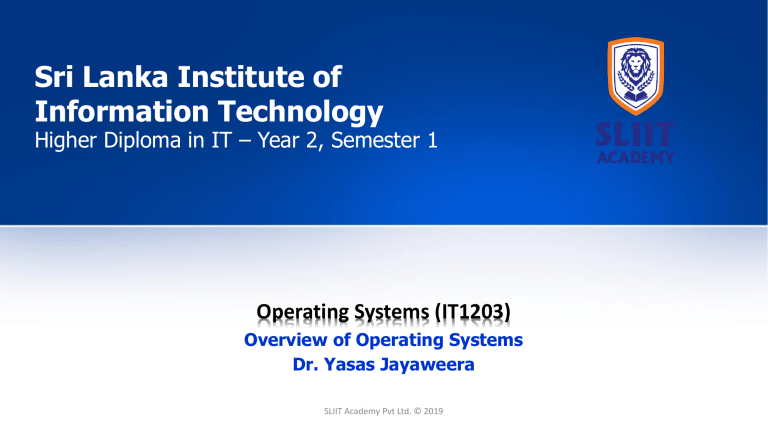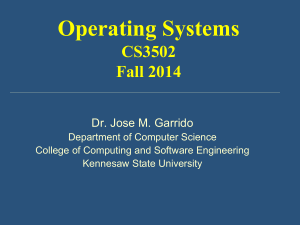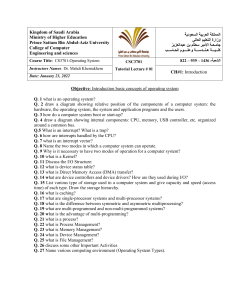
Sri Lanka Institute of Information Technology Higher Diploma in IT – Year 2, Semester 1 Operating Systems (IT1203) Overview of Operating Systems Dr. Yasas Jayaweera SLIIT Academy Pvt Ltd. © 2019 Contents ▪ Operating Systems ▪ Organization ▪ Architecture ▪ Structure ▪ System Operations Objectives ▪ ▪ ▪ ▪ To describe the basic organization of computer systems To provide a tour of the major components of operating systems To give an overview of the many types of computing environments To explore several open-source operating systems Course Assessments ▪ Continuous Assessments =40% ▪ Midterm 20% ▪ Online Assignments 10% ▪ Class Tests 10% ▪ Final Exam (Written) =60% ▪ Enrollment Key: OS2023 ▪ Principal reference book Operating System Concepts, Tength Edition, Avi Silberschatz Peter Baer Galvin, Greg Gagne, John Wiley & Sons, Inc. ISBN 978-1-119-32091-3 What is an Operating System? ▪ A program that acts as an intermediary between a user of a computer and the computer hardware ▪ Operating system goals: ▪ Execute user programs and make solving user problems easier ▪ Make the computer system convenient to use ▪ Use the computer hardware in an efficient manner Types SLIIT Academy Pvt Ltd. © 2019 6 Four Components of a Computer System Computer System Structure ▪ Computer system can be divided into four components: ▪ Hardware – provides basic computing resources ▪ CPU, memory, I/O devices ▪ Operating system ▪ Controls and coordinates use of hardware among various applications and users ▪ Application programs – define the ways in which the system resources are used to solve the computing problems of the users ▪ Word processors, compilers, web browsers, database systems, video games ▪ Users ▪ People, machines, other computers Views of Operating Systems –User ▪ Users want convenience, ease of use and good performance ▪ Don’t care about resource utilization ▪ But shared computer such as mainframe or minicomputer must keep all users happy ▪ Workstations have dedicated resources but frequently use shared resources from servers ▪ Handheld computers are resource poor, optimized for usability and battery life ▪ Some computers have little or no user interface, such as embedded computers in devices and automobiles Views of Operating Systems –System ▪ OS is a resource allocator ▪ OS is a control program Operating System Definition (Cont.) ▪ No universally accepted definition ▪ “The one program running at all times on the computer” is the kernel. ▪ Everything else is either ▪ a system program (ships with the operating system) , or ▪ an application program. Computer Startup ▪ bootstrap program is loaded at power-up or reboot ▪ Typically stored in ROM or EEPROM, generally known as firmware BIOS MBR Bootloader Kernel Computer System Organization ▪ Computer-system operation ▪ Concurrent execution of CPUs and devices competing for memory cycles Computer-System Operation ▪ Device controller informs CPU that it has finished its operation by causing an interrupt. ▪ Interrupt transfers control to the interrupt service routine generally, through the interrupt vector, which contains the addresses of all the service routines. ▪ A trap or exception is a software-generated interrupt caused either by an error or a user request. ▪ An operating system is interrupt driven What is an interrupt? SLIIT Academy Pvt Ltd. © 2019 15 Interrupt Handling ▪ Determines which type of interrupt has occurred: ▪ polling ▪ vectored interrupt system ▪ Separate segments of code determine what action should be taken for each type of interrupt Interrupt Handling SLIIT Academy Pvt Ltd. © 2019 17 I/O Structure Synchronous I/O After I/O starts, control returns to user program only upon I/O completion Asynchronous I/O After I/O starts, control returns to user program without waiting for I/O completion but need ▪ System call – request to the OS to allow user to wait for I/O completion ▪ Device-status table contains entry for each I/O device indicating its type, address, and state Storage Definitions and Notation Review Storage-Device Hierarchy Based on; Speed Cost Volatility Performance of Various Levels of Storage Movement between levels of storage hierarchy can be explicit or implicit Caching ▪ Information in use copied from slower to faster storage temporarily ▪ Faster storage (cache) checked first to determine if information is there ▪ If it is, information used directly from the cache (fast) ▪ If not, data copied to cache and used there Direct Memory Access Structure ▪ Used for high-speed I/O devices able to transmit information at close to memory speeds ▪ Only one interrupt is generated per block, rather than the one interrupt per byte A von Neumann architecture Computer-System Architecture ▪ Most systems use a single general-purpose processor ▪ Most systems have special-purpose processors as well ▪ Multiprocessors systems growing in use and importance ▪ Also known as parallel systems, tightly-coupled systems ▪ Advantages include: 1. Increased throughput 2. Economy of scale 3. Increased reliability – graceful degradation or fault tolerance ▪ Two types: 1. Asymmetric Multiprocessing – each processor is assigned a specific task. 2. Symmetric Multiprocessing – each processor performs all tasks Symmetric Multiprocessing Architecture A Dual-Core Design ▪ Multi-chip and multicore ▪ Systems containing all chips ▪ Chassis containing multiple separate systems Clustered Systems ▪ Like multiprocessor systems, but multiple systems working together ▪ Usually sharing storage via a storage-area network (SAN) ▪ Provides a high-availability service which survives failures ▪ Asymmetric clustering has one machine in hot-standby mode ▪ Symmetric clustering has multiple nodes running applications, monitoring each other Clustered Systems Operating System Structure ▪ Multiprogramming needed for efficiency ▪ Single user cannot keep CPU and I/O devices busy at all times ▪ Multiprogramming organizes jobs (code and data) so CPU always has one to execute ▪ A subset of total jobs in system is kept in memory ▪ Timesharing is logical extension in which CPU switches jobs so frequently that users can interact with each job while it is running, creating interactive computing ▪ Each user has at least one program executing in memory ▪ Several jobs ready to run at the same time Memory Layout for Multiprogrammed System Operating-System Operations (cont.) ▪ Dual-mode operation allows OS to protect itself and other system components ▪ User mode and kernel mode ▪ Mode bit provided by hardware ▪ Provides ability to distinguish when system is running user code or kernel code ▪ Some instructions designated as privileged, only executable in kernel mode ▪ System call changes mode to kernel, return from call resets it to user Transition from User to Kernel Mode Process Management ▪ A process is a program in execution. It is a unit of work within the system. Program is a passive entity, process is an active entity. ▪ Process needs resources to accomplish its task ▪ CPU, memory, I/O, files ▪ Initialization data Process Management Activities The operating system is responsible for the following activities in connection with process management: ▪ ▪ ▪ ▪ ▪ Creating and deleting both user and system processes Suspending and resuming processes Providing mechanisms for process synchronization Providing mechanisms for process communication Providing mechanisms for deadlock handling Memory Management ▪ Memory management activities ▪ Keeping track of which parts of memory are currently being used and by whom ▪ Deciding which processes (or parts thereof) and data to move into and out of memory ▪ Allocating and deallocating memory space as needed Storage Management ▪ OS provides uniform, logical view of information storage ▪ Abstracts physical properties to logical storage unit - file ▪ Each medium is controlled by device (i.e., disk drive, tape drive) ▪ File-System management ▪ Files usually organized into directories ▪ Access control on most systems to determine who can access what ▪ OS activities include ▪ ▪ ▪ ▪ Creating and deleting files and directories Primitives to manipulate files and directories Mapping files onto secondary storage Backup files onto stable (non-volatile) storage media Mass-Storage Management ▪ Usually disks used to store data that does not fit in main memory or data that must be kept for a “long” period of time ▪ OS activities ▪ Free-space management ▪ Storage allocation ▪ Disk scheduling I/O Subsystem ▪ One purpose of OS is to hide peculiarities of hardware devices from the user ▪ I/O subsystem responsible for ▪ Memory management of I/O including buffering (storing data temporarily while it is being transferred), caching (storing parts of data in faster storage for performance), spooling (the overlapping of output of one job with input of other jobs) ▪ General device-driver interface ▪ Drivers for specific hardware devices Protection and Security ▪ Protection – any mechanism for controlling access of processes or users to resources defined by the OS ▪ Security – defense of the system against internal and external attacks ▪ Huge range, including denial-of-service, worms, viruses, identity theft, theft of service ▪ Systems generally first distinguish among users, to determine who can do what ▪ User identities (user IDs, security IDs) include name and associated number, one per user ▪ User ID then associated with all files, processes of that user to determine access control ▪ Group identifier (group ID) allows set of users to be defined and controls managed, then also associated with each process, file ▪ Privilege escalation allows user to change to effective ID with more rights Computing Environments - Traditional ▪ Stand-alone general purpose machines ▪ But blurred as most systems interconnect with others (i.e., the Internet) ▪ Portals provide web access to internal systems ▪ Network computers (thin clients) are like Web terminals ▪ Mobile computers interconnect via wireless networks ▪ Networking becoming ubiquitous – even home systems use firewalls to protect home computers from Internet attacks Computing Environments - Mobile ▪ Handheld smartphones, tablets, etc ▪ What is the functional difference between them and a “traditional” laptop? ▪ Extra feature – more OS features (GPS, gyroscope) ▪ Allows new types of apps like augmented reality ▪ Leaders are Apple iOS and Google Android Computing Environments – Distributed ▪ Distributed computing ▪ Collection of separate, possibly heterogeneous, systems networked together Computing Environments – Client-Server Client-Server Computing Dumb terminals supplanted by smart PCs Many systems now servers, responding to requests generated by clients Compute-server system provides an interface to client to request services (i.e., database) File-server system provides interface for clients to store and retrieve files Computing Environments - Peer-to-Peer ▪ Another model of distributed system ▪ P2P does not distinguish clients and servers ▪ Instead all nodes are considered peers ▪ May each act as client, server or both ▪ Examples include Napster and Gnutella, Voice over IP (VoIP) such as Skype Computing Environments - Virtualization ▪ Allows operating systems to run applications within other OSes ▪ Vast and growing industry ▪ Emulation used when source CPU type different from target type (i.e. PowerPC to Intel x86) ▪ Generally slowest method ▪ When computer language not compiled to native code – Interpretation ▪ Virtualization – OS natively compiled for CPU, running guest OSes also natively compiled ▪ Consider VMware running WinXP guests, each running applications, all on native WinXP host OS ▪ VMM (virtual machine Manager) provides virtualization services Computing Environments - Virtualization ▪ Use cases involve laptops and desktops running multiple OSes for exploration or compatibility ▪ Apple laptop running Mac OS X host, Windows as a guest ▪ QA testing applications without having multiple systems Computing Environments – Emulation vs Simulation Computing Environments – Cloud Computing ▪ ▪ ▪ Delivers computing, storage, even apps as a service across a network Logical extension of virtualization because it uses virtualization as the base for it functionality. ▪ Amazon EC2 has thousands of servers, millions of virtual machines, petabytes of storage available across the Internet, pay based on usage Many types ▪ Public cloud – available via Internet to anyone willing to pay ▪ Private cloud – run by a company for the company’s own use ▪ Hybrid cloud – includes both public and private cloud components ▪ Software as a Service (SaaS) – one or more applications available via the Internet (i.e., word processor) ▪ Platform as a Service (PaaS) – software stack ready for application use via the Internet (i.e., a database server) ▪ Infrastructure as a Service (IaaS) – servers or storage available over Internet (i.e., storage available for backup use) Computing Environments – Cloud Computing Source: https://www.google.com/url?sa=i&rct=j&q=&esrc=s&source=images&cd=&cad=rja&uact=8&ved=2ahUKEwjwkPrwnezmAhUjzTgGHQvTAoYQjhx6BAgBEAI&url=https%3A%2F%2Fen.wikipedia.org%2Fwiki%2FCloud_computing&psig=AOvVaw06cxlYJ6kua9Q1McWVHre&ust=1578305921303305 Computing Environments – Real-Time Embedded Systems ▪ Real-time OS has well-defined fixed time constraints ▪ Processing must be done within constraint ▪ Correct operation only if constraints met ▪ 2 types ▪ HRTOS ▪ SRTOS Open-Source Operating Systems ▪ Operating systems made available in source-code format rather than just binary closed-source ▪ Counter to the copy protection and Digital Rights Management (DRM) movement ▪ Started by Free Software Foundation (FSF), which has “copyleft” GNU Public License (GPL) ▪ Examples include GNU/Linux and BSD UNIX (including core of Mac OS X), and many more ▪ Can use VMM like VMware Player (Free on Windows), Virtualbox (open source and free on many platforms http://www.virtualbox.com) ▪ Use to run guest operating systems for exploration Thank You 52








